
Planning and data collection are two critical components of research that are essential for obtaining accurate and reliable results. Planning involves defining the research problem, identifying the research questions, and developing a research design that outlines the methods and procedures to be used in data collection. Data collection, on the other hand, is the process of gathering information or observations that are relevant to the research problem.
The first step in planning is to define the research problem. This involves identifying the issue that needs to be addressed and formulating one or more research questions that precisely define what needs to be found out. Depending on the research questions, quantitative or qualitative data may be required. Quantitative data is expressed in numbers and graphs and is analyzed through statistical methods, while qualitative data is expressed in words and analyzed through interpretations and categorizations. If the research aims to test a hypothesis, measure something precisely, or gain large-scale statistical insights, quantitative data is collected. If the research aims to explore ideas, understand experiences, or gain detailed insights into a specific context, qualitative data is collected. If there are several aims, a mixed-methods approach that collects both types of data can be used.
The second step in planning is to choose the data collection method. Based on the data that needs to be collected, the most appropriate method is selected. The method chosen should be reliable, valid, and ethical. Some common data collection methods include surveys, interviews, focus groups, observation, and experiments. Surveys are used to collect data from a large number of people, while interviews are used to collect data from a smaller number of people in greater depth. Focus groups are used to collect data from a group of people who share similar characteristics or experiences. Observation is used to collect data by observing people or events in their natural setting, while experiments are used to collect data by manipulating variables in a controlled environment.
The third step in planning is to plan the data collection procedures. This involves operationalizing the variables, developing a sampling plan, and designing the data collection instruments. Operationalization is the process of defining how the variables will be measured. Sometimes variables can be measured directly, while other times they need to be measured indirectly. Developing a sampling plan involves defining the population, selecting the sample, and determining the sample size. The sample should be representative of the population to ensure that the results are generalizable. Designing the data collection instruments involves developing questionnaires, interview guides, observation protocols, or experimental procedures that are valid and reliable.
The fourth and final step in planning is to collect the data. This involves implementing
